KEEPING ONE MONTROSE TREE IN RESERVE 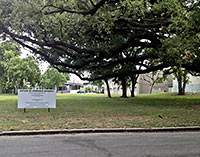 The developer of those spur-side homes planned for this Westmoreland lot between Marshall and W. Alabama St. says that the old live oak shown in the photo isn’t going anywhere. In fact, Arpan Gupta tells Swamplot that a 1,410-sq.-ft. reserve area — as one commenter notes on the site plan — is being established around the tree’s “drip line” to set aside a park that not just the homeowners will be allowed to use. Additionally, explains Gupta, architecture firm Knudson and tree service Arbor Care have both been employed to take protective measures — mulching, fertilizing, fencing, etc. — during the “stress of construction.” [Previously on Swamplot] Photo: Allyn West
The developer of those spur-side homes planned for this Westmoreland lot between Marshall and W. Alabama St. says that the old live oak shown in the photo isn’t going anywhere. In fact, Arpan Gupta tells Swamplot that a 1,410-sq.-ft. reserve area — as one commenter notes on the site plan — is being established around the tree’s “drip line” to set aside a park that not just the homeowners will be allowed to use. Additionally, explains Gupta, architecture firm Knudson and tree service Arbor Care have both been employed to take protective measures — mulching, fertilizing, fencing, etc. — during the “stress of construction.” [Previously on Swamplot] Photo: Allyn West
Quicklink
BIDS TO BUY LAW ENFORCEMENT HS PUNISHED FOR NOT FOLLOWING RULES 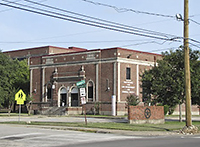 HISD gave a unanimous no today to those competing bids from nearby St. Thomas High School and developer AV Dickson Street to buy the High School for Law Enforcement and Criminal Justice in Magnolia Grove. Apparently, the reason the offers for the 11-acre campus at 4701 Dickson St. were rejected had less to do with the numbers than with HISD’s preferred S.O.P.: “[T]he board’s attorney, David Thompson, stated immediately afterward that both bidders had violated the district’s ‘code of silence’ policy, which prohibits communication between trustees and those with pending business before them.” Superintendent Terry Grier tells the Houston Chronicle that the building will be going right back on the market: “Hopefully if we do that, the bidders will take our ethics policy seriously.” [Houston Chronicle; previously on Swamplot] Photo: HISD
HISD gave a unanimous no today to those competing bids from nearby St. Thomas High School and developer AV Dickson Street to buy the High School for Law Enforcement and Criminal Justice in Magnolia Grove. Apparently, the reason the offers for the 11-acre campus at 4701 Dickson St. were rejected had less to do with the numbers than with HISD’s preferred S.O.P.: “[T]he board’s attorney, David Thompson, stated immediately afterward that both bidders had violated the district’s ‘code of silence’ policy, which prohibits communication between trustees and those with pending business before them.” Superintendent Terry Grier tells the Houston Chronicle that the building will be going right back on the market: “Hopefully if we do that, the bidders will take our ethics policy seriously.” [Houston Chronicle; previously on Swamplot] Photo: HISD
COMMENT OF THE DAY: PARKING IN THE FRONT, BUSINESS IN THE BACK 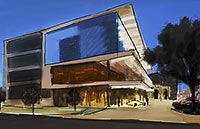 “It’s not BS. Local independent businesses may be relatively willing to provide their parking on the side / back / top / below or wherever. But I’ve heard from several retail developers that convincing a ‘credit tenant’ to lease in a structure that doesn’t have off-street front-door parking can be a major challenge, even if there’s an oversupply of parking elsewhere on site.
The developer of BLVD place wanted to put the development right up along the Post Oak Boulevard sidewalk –– and at the time there was the expectation there would be a light rail station right there. This was going to be done, I believe, without seeking a setback variance (and the Transit Corridor Ordinance in 2009 obviated the need for one anyway). But the tenants that were sought refused to come unless a parking lot was put in front –– the internal parking structure wasn’t enough for them. And so, the plan was redesigned with off-street parking in front, and the tenants came.
I don’t mean to imply support for the setback requirement –– I think in most cases it hurts way more than it helps and should be eliminated, or at least modified to not require a variance for more sidewalk-friendly development. Did you know that Kirby from Westheimer to US 59 is a Major Thoroughfare, therefore requiring a 25 foot setback from the right of way for new development? Same with Montrose from W. Dallas to US 59. Is this what we want for the primary streets of some of Houston’s most ‘urban’ neighborhoods, the very center of our city? In my opinion, this is ridiculous.” [Local Planner, commenting on Comment of the Day: When Houston Buildings Weren’t So Shy of the Street] Illustration: Lulu
“It’s not BS. Local independent businesses may be relatively willing to provide their parking on the side / back / top / below or wherever. But I’ve heard from several retail developers that convincing a ‘credit tenant’ to lease in a structure that doesn’t have off-street front-door parking can be a major challenge, even if there’s an oversupply of parking elsewhere on site.
The developer of BLVD place wanted to put the development right up along the Post Oak Boulevard sidewalk –– and at the time there was the expectation there would be a light rail station right there. This was going to be done, I believe, without seeking a setback variance (and the Transit Corridor Ordinance in 2009 obviated the need for one anyway). But the tenants that were sought refused to come unless a parking lot was put in front –– the internal parking structure wasn’t enough for them. And so, the plan was redesigned with off-street parking in front, and the tenants came.
I don’t mean to imply support for the setback requirement –– I think in most cases it hurts way more than it helps and should be eliminated, or at least modified to not require a variance for more sidewalk-friendly development. Did you know that Kirby from Westheimer to US 59 is a Major Thoroughfare, therefore requiring a 25 foot setback from the right of way for new development? Same with Montrose from W. Dallas to US 59. Is this what we want for the primary streets of some of Houston’s most ‘urban’ neighborhoods, the very center of our city? In my opinion, this is ridiculous.” [Local Planner, commenting on Comment of the Day: When Houston Buildings Weren’t So Shy of the Street] Illustration: Lulu
FEEDING NEW APARTMENTS TO THE GRAND PKWY. FEEDER 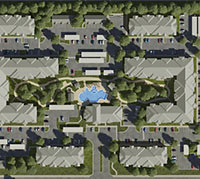 Austin developers Oden Hughes say that they have been eager to build in Houston, but the company’s first project here has come only as far east as Katy: A 354-unit apartment complex is going up a few miles east of Katy Mills Mall on 14 acres at the southwest corner of Kingsland Blvd. and the southbound Grand Pkwy. feeder. The Rancher reports that rent here at the so-called Parkside Grand Parkway will range between $850 and $1,655 a month for the complex planned to include 2 pools, a fitness center, and “an air-conditioned dog washing station.” [The Rancher] Rendering: Oden Hughes
Austin developers Oden Hughes say that they have been eager to build in Houston, but the company’s first project here has come only as far east as Katy: A 354-unit apartment complex is going up a few miles east of Katy Mills Mall on 14 acres at the southwest corner of Kingsland Blvd. and the southbound Grand Pkwy. feeder. The Rancher reports that rent here at the so-called Parkside Grand Parkway will range between $850 and $1,655 a month for the complex planned to include 2 pools, a fitness center, and “an air-conditioned dog washing station.” [The Rancher] Rendering: Oden Hughes
DIPPING INTO DOWNTOWN’S BAR SCENE 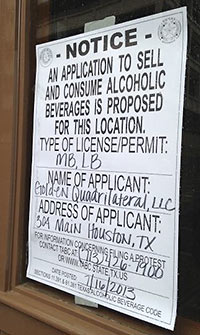 Tweeting this photo of its brand-new TABC sign in the window at 304 Main St., Little Dipper has emerged in Downtown’s twinkling constellation of new bars and restaurants: Eater Houston reports that this proposed bar is owned by the same folks who have brought you Poison Girl on Westheimer and coffee shops Black Hole on Graustark and Antidote on Studewood. It appears that the Little Dipper will be going into the space right next to ramen shop Goro & Gun at 306 Main, just around the corner from the OKRA Charity Saloon on Congress and that lot catty-corner from Market Square Park where Hines has said it is considering building a residential tower. [Eater Houston; previously on Swamplot] Photo: @littledipperbar
Tweeting this photo of its brand-new TABC sign in the window at 304 Main St., Little Dipper has emerged in Downtown’s twinkling constellation of new bars and restaurants: Eater Houston reports that this proposed bar is owned by the same folks who have brought you Poison Girl on Westheimer and coffee shops Black Hole on Graustark and Antidote on Studewood. It appears that the Little Dipper will be going into the space right next to ramen shop Goro & Gun at 306 Main, just around the corner from the OKRA Charity Saloon on Congress and that lot catty-corner from Market Square Park where Hines has said it is considering building a residential tower. [Eater Houston; previously on Swamplot] Photo: @littledipperbar
COMMENT OF THE DAY: HUNTING FOR BURIED TREASURE AT CAMP STRAKE  “I was once on a campout there and some guy in my troop, in the process of digging a hole for something, found an early 1940′s Walking Liberty half dollar, the most beautiful coin the U.S. mint ever produced. Suddenly we were all seized with hysteria. Old silver coins! In the ground! Right beneath us! And it just so happened that one of the scout masters had a metal detector. So at the behest of a dozen crazed boys in their early teens, he led us off on an afternoon mission seeking treasure. Each boy took turns claiming whatever was unearthed in the next metal strike. The beeping sounded, the digging commenced, up came an old rusty nail. Ten minutes later beeping again, excitement, digging, rusty nail. On and on, crisscrossing Camp Strake, through the woods, down the dirt roads, along the lake: rusty nail, rusty nail, rusty nail. Our numbers dwindled; soon it was just me and one other guy, dreaming of coins, digging up nails. And then it was evening and we gave up. All those little holes. A bucket full of rusty nails.” [Mike, commenting on Boy Scouts Sell Camp Strake in Conroe To Master-Planned Community Master Planners] Illustration: Lulu
“I was once on a campout there and some guy in my troop, in the process of digging a hole for something, found an early 1940′s Walking Liberty half dollar, the most beautiful coin the U.S. mint ever produced. Suddenly we were all seized with hysteria. Old silver coins! In the ground! Right beneath us! And it just so happened that one of the scout masters had a metal detector. So at the behest of a dozen crazed boys in their early teens, he led us off on an afternoon mission seeking treasure. Each boy took turns claiming whatever was unearthed in the next metal strike. The beeping sounded, the digging commenced, up came an old rusty nail. Ten minutes later beeping again, excitement, digging, rusty nail. On and on, crisscrossing Camp Strake, through the woods, down the dirt roads, along the lake: rusty nail, rusty nail, rusty nail. Our numbers dwindled; soon it was just me and one other guy, dreaming of coins, digging up nails. And then it was evening and we gave up. All those little holes. A bucket full of rusty nails.” [Mike, commenting on Boy Scouts Sell Camp Strake in Conroe To Master-Planned Community Master Planners] Illustration: Lulu
COMMENT OF THE DAY: WHEN HOUSTON BUILDINGS WEREN’T SO SHY OF THE STREET 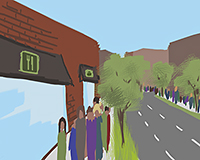 “The main reason these old buildings are so charming is their zero-foot setback from the front property line, which results in a much more pedestrian-friendly streetscape.
Ever since the City created the Chapter 42 development requirements, with 25-ft setbacks along major thoroughfares (of which Washington is one) and minimum parking requirements, retail development shifted from pedestrian-friendly zero building line (e.g. 19th St or Rice Village) to strip centers with two rows of parking in front.
After all, if you can’t build within 25 feet of the building line, you might as well put cars there.” [Angostura, commenting on A Restaurant Renovation in the Old Sixth Ward] Illustration: Lulu
“The main reason these old buildings are so charming is their zero-foot setback from the front property line, which results in a much more pedestrian-friendly streetscape.
Ever since the City created the Chapter 42 development requirements, with 25-ft setbacks along major thoroughfares (of which Washington is one) and minimum parking requirements, retail development shifted from pedestrian-friendly zero building line (e.g. 19th St or Rice Village) to strip centers with two rows of parking in front.
After all, if you can’t build within 25 feet of the building line, you might as well put cars there.” [Angostura, commenting on A Restaurant Renovation in the Old Sixth Ward] Illustration: Lulu
DUNKIN’ DONUTS WON’T OPEN MONTROSE LOCATION FOR ANOTHER WEEK 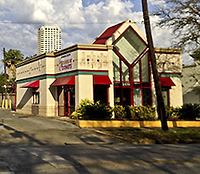 You might have read here or here that the first one to open inside the Loop of those 24 new Dunkin’ Donuts locations would be ready tomorrow at the former Arby’s on the corner of Fairview and S. Shepherd. Well, it won’t be. A company rep writes in an email that the S. Shepherd team won’t be making (or selling) the donuts until next Monday, July 22. A grander opening will follow on July 30. (You can head to the new one in Westchase if you can’t wait.) [29-95; Eater Houston; previously on Swamplot] Photo: Swamplot inbox
You might have read here or here that the first one to open inside the Loop of those 24 new Dunkin’ Donuts locations would be ready tomorrow at the former Arby’s on the corner of Fairview and S. Shepherd. Well, it won’t be. A company rep writes in an email that the S. Shepherd team won’t be making (or selling) the donuts until next Monday, July 22. A grander opening will follow on July 30. (You can head to the new one in Westchase if you can’t wait.) [29-95; Eater Houston; previously on Swamplot] Photo: Swamplot inbox
COMMENT OF THE DAY: VISIONS OF A FREEWAY LINED WITH OFFICE BUILDINGS  “I live in the area and I think it’s a big improvement on a used car lot. I would love to see the remaining car dealerships gradually moved away and a continuous strip of mid/high rises from Memorial City to Hwy 6. Now that would be a true ‘Energy Corridor.’†[outwest, commenting on A New 17-Story Office Tower Just Like the Others in the Energy Corridor] Illustration: Lulu
“I live in the area and I think it’s a big improvement on a used car lot. I would love to see the remaining car dealerships gradually moved away and a continuous strip of mid/high rises from Memorial City to Hwy 6. Now that would be a true ‘Energy Corridor.’†[outwest, commenting on A New 17-Story Office Tower Just Like the Others in the Energy Corridor] Illustration: Lulu
COMMENT OF THE DAY RUNNER-UP: HOW AND WHERE HOUSTON’S GONNA FIT ALL THOSE NEWCOMERS  “More density is coming to the Heights and every other Inner Loop neighborhood, because the economic factors at work are unstoppable. Barring a disaster wrecking Houston (natural or otherwise) or an economic crash, more people are coming, and lots of them will want to live near the central parts of the city. All we’re debating is how that will happen. Will needed infrastructure improvements happen? Will there be better transit? Will the density be added in a way to preserves the original neighborhood, and what does that look like?
I have no problem with this kind of development along Yale or Studewood. I think an ideal outcome is main streets with good transit access and dense housing, retail, etc. with historically significant neighborhoods preserved nearby. I think what Arlington County, VA has done along these lines stands as an excellent example.
And the idea that renters bring a neighborhood down is just stupid. unless your idea of a dynamic Heights is one where the average age is 50.” [John (another one), commenting on A Second Midrise Alexan Planned Right Beside the First One on Yale] Illustration: Lulu
“More density is coming to the Heights and every other Inner Loop neighborhood, because the economic factors at work are unstoppable. Barring a disaster wrecking Houston (natural or otherwise) or an economic crash, more people are coming, and lots of them will want to live near the central parts of the city. All we’re debating is how that will happen. Will needed infrastructure improvements happen? Will there be better transit? Will the density be added in a way to preserves the original neighborhood, and what does that look like?
I have no problem with this kind of development along Yale or Studewood. I think an ideal outcome is main streets with good transit access and dense housing, retail, etc. with historically significant neighborhoods preserved nearby. I think what Arlington County, VA has done along these lines stands as an excellent example.
And the idea that renters bring a neighborhood down is just stupid. unless your idea of a dynamic Heights is one where the average age is 50.” [John (another one), commenting on A Second Midrise Alexan Planned Right Beside the First One on Yale] Illustration: Lulu
RICHMOND STRIP NOT DOWN FOR THE COUNT? 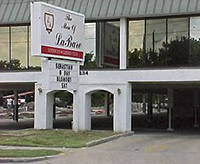 Real estate reporter Shaina Zucker cruises Richmond Ave., tallying up the evidence that she suggests might just point to a resurgence of that once-lively strip between Hillcroft and Chimney Rock: “30 — The number of For Lease signs visible; 4 — The number of For Sale signs visible; 6 — The number of empty lots visible; 5 — Number of active adult entertainment locations (strip clubs, novelty stores, etc.); 8 — Number of other active clubs/bars facing Richmond; 6 — Number of open fast-food locations; 20 — Number of auto sales/retailer locations; 3 — Number of active construction projects; 35,127 — Richmond at Fountain View average daily traffic volume by number of vehicles; 33,720 — Richmond at Chimney Rock average daily traffic volume by number of vehicles.” [Houston Business Journal] Photo of La Bare at 6234 Richmond: City Data
Real estate reporter Shaina Zucker cruises Richmond Ave., tallying up the evidence that she suggests might just point to a resurgence of that once-lively strip between Hillcroft and Chimney Rock: “30 — The number of For Lease signs visible; 4 — The number of For Sale signs visible; 6 — The number of empty lots visible; 5 — Number of active adult entertainment locations (strip clubs, novelty stores, etc.); 8 — Number of other active clubs/bars facing Richmond; 6 — Number of open fast-food locations; 20 — Number of auto sales/retailer locations; 3 — Number of active construction projects; 35,127 — Richmond at Fountain View average daily traffic volume by number of vehicles; 33,720 — Richmond at Chimney Rock average daily traffic volume by number of vehicles.” [Houston Business Journal] Photo of La Bare at 6234 Richmond: City Data
COMMENT OF THE DAY: HOW DID HOUSTON CHANGE FROM TOWNHOMES TO APARTMENTS? 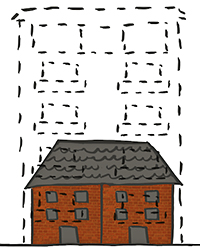 “Before the financial crash in 2008, developers were giddy to get large lots such as these and develop them into townhomes or high-end single family residential. See, for example, the townhomes that sit up against the railroad tracks on Center Street that now have a view of the Wal Mart parking lot. Or the gated community at Washington Ave. and Memorial Heights.
Since then, I’m seeing more of these parcels developed into mid rise apartments, or shopping centers. Did something change in regards to bank financing or is this a response to more out of town money investing in Houston because it’s a ‘hot market’? Does anyone here know the answer?” [ShadyHeightster, commenting on A Second Midrise Alexan Planned Right Beside the First One on Yale] Illustration: Lulu
“Before the financial crash in 2008, developers were giddy to get large lots such as these and develop them into townhomes or high-end single family residential. See, for example, the townhomes that sit up against the railroad tracks on Center Street that now have a view of the Wal Mart parking lot. Or the gated community at Washington Ave. and Memorial Heights.
Since then, I’m seeing more of these parcels developed into mid rise apartments, or shopping centers. Did something change in regards to bank financing or is this a response to more out of town money investing in Houston because it’s a ‘hot market’? Does anyone here know the answer?” [ShadyHeightster, commenting on A Second Midrise Alexan Planned Right Beside the First One on Yale] Illustration: Lulu
COMMENT OF THE DAY: ASHES TO ASHES, DUST TO DUSTING  “Looking at that house on Deal, I think, as I often do with the daily demolitions: that looks so wonderfully easy to keep clean. You’d have a little time to sit and drink iced tea on that side entry porch. Where others see a space to fill — and I realize that’s the better impulse, ultimately, to want to build something, even something as hideous as the house across the street — I just see time. That’s the direction my thoughts take 7665 days of housework later.” [luciaphile, commenting on Daily Demolition Report: Deal and No Deal] Illustration: Lulu
“Looking at that house on Deal, I think, as I often do with the daily demolitions: that looks so wonderfully easy to keep clean. You’d have a little time to sit and drink iced tea on that side entry porch. Where others see a space to fill — and I realize that’s the better impulse, ultimately, to want to build something, even something as hideous as the house across the street — I just see time. That’s the direction my thoughts take 7665 days of housework later.” [luciaphile, commenting on Daily Demolition Report: Deal and No Deal] Illustration: Lulu
COMMENT OF THE DAY RUNNER-UP: HOUSTON HAS ITS COMMUTER RAIL ALREADY, AND IT’S SPELLED H-O-V  “(1) We have one of the best suburb-to-downtown commuter transit systems in the country in the form of the HOV buses, which METRO has invested a lot of money into (the HOV lanes and transit centers cost $1 billion or so to build, and the service is more expensive to operate per rider than either rail or local bus.) 50% of the people who work downtown and live in the areas served by the park & rides already take transit. Commuter rail would be slower, less frequent, and less convenient. The 290 study showed that a $300 million commuter rail line could actually decrease transit ridership. So why should we build commuter rail in corridors that already have park & ride?
(2) Grade separated rail is great, but it’s not cheaper — cost is twice or more of at grade. Subway is 4 times or more. So the question is not if grade separation is good; the question is if grade separation is worth the extra cost. And nobody — not even Chicago — is building elevated rail above city streets, so if you want to grade separate you either need to be lucky enough to have an old rail line or a freeway exactly where people want to go or you need to pay for a subway.” [Christof Spieler, commenting on Comment of the Day: Developing at the Speed of Light Rail] Illustration: Lulu
“(1) We have one of the best suburb-to-downtown commuter transit systems in the country in the form of the HOV buses, which METRO has invested a lot of money into (the HOV lanes and transit centers cost $1 billion or so to build, and the service is more expensive to operate per rider than either rail or local bus.) 50% of the people who work downtown and live in the areas served by the park & rides already take transit. Commuter rail would be slower, less frequent, and less convenient. The 290 study showed that a $300 million commuter rail line could actually decrease transit ridership. So why should we build commuter rail in corridors that already have park & ride?
(2) Grade separated rail is great, but it’s not cheaper — cost is twice or more of at grade. Subway is 4 times or more. So the question is not if grade separation is good; the question is if grade separation is worth the extra cost. And nobody — not even Chicago — is building elevated rail above city streets, so if you want to grade separate you either need to be lucky enough to have an old rail line or a freeway exactly where people want to go or you need to pay for a subway.” [Christof Spieler, commenting on Comment of the Day: Developing at the Speed of Light Rail] Illustration: Lulu
COMMENT OF THE DAY SECOND RUNNER-UP: NO ZONING MEANS WE’LL ALWAYS HAVE TRAFFIC SURPRISES “If there was only a way to plan for traffic and infrastructure by knowing the density that a site will have in the future . . . Oh yeah, its called Zoning. Then you know the worst case development scenario. And if you ever want to build bigger than you have to upgrade the infrastructure first. Nah, why do that, we can just let people build as big as they want and try and fix the problems later. Unless you are for zoning and rules than you can’t complain about traffic. They are the same. [DD, commenting on A Second Midrise Alexan Planned Right Beside the First One on Yale]

